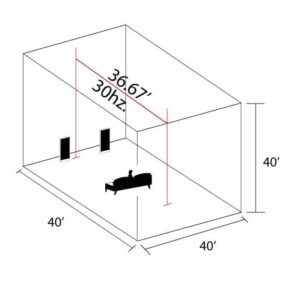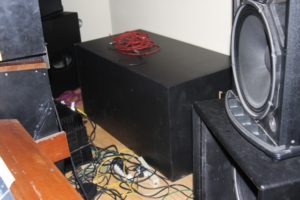Control Rooms
In our control rooms, we usually have two sets of monitors and one control room subwoofer. We have smaller monitors that we use for near field listening and a larger pair that we use which includes the room sound. With these larger monitors, we usually see a single or pair of sub woofers for more low end impact. More low end impact produces more room energy and all the associated room resonances that go with longer wavelengths in our smaller rooms. Some clients prefer low end impact, some don’t.
Energy Must Fit
Lets take a 30 Hz. wavelength which is almost 37′ long. If our room is 40′ long, the 30 Hz. this wavelength fits within the 40′ room dimension. If our width and height are also 40′, then we have a room with the necessary room volume for adequate, low frequency, sound pressure to spread out and not run up against a nearby boundary surface and cause pressure build ups within the room. These pressure build ups or room resonances can have a height, width, and even depth to the area that they occupy within our control rooms which can completely cover other frequencies.
Subs By Monitors
A control room subwoofer is usually placed towards the front of the control room. They are centered between the monitors and usually on the floor under the console somewhere. All of this energy spreads out and strikes the side walls and ceiling. If room dimensions are not compatible with the length of the low frequency waves, then we have room modal issues that can impact the monitoring position. Yes, we will have more sound pressure into the room, but at what cost.
Room Modes
Low frequency room modes can blur or smoother other frequencies that “live” within their room area. These pressure modes have a height, width, and even a length to them. They are powerful and are not wanted in our control rooms or critical listening environments. We especially do not want then at the monitoring position where their magnitude can interfere with other frequencies. We want the room sound minimized at the monitoring position, not overwhelming as is the case with room modes, especially those produced by sub woofers.
Only Two Types Of Absorption
To effectively manage, it is almost impossible to eliminate low frequency pressure issues within our room. The best we can usually do is to reduce the impact they have on the intended use of the room. To accomplish this, we can use two versions of low frequency, sound absorption, technology to reduce some of the excess energy. You can use a Helmholtz resonator or a diaphragmatic absorber. Both are similar in their approach to absorbing low frequency energy, but different in the way they go about achieving their respective design goals.
Helmholtz Resonator
A Helmholtz resonator can be thought of as a bottle or a jug. If you blow across the mouth of the cavity of the bottle or jug, you excite the air inside the bottle and this air then begins to move in a springy effect to create a resonate system. The natural frequency of resonance of the bottle or jug is determined by the length of the jug or bottle. Frequencies above the Helmholtz resonator resonant frequency are absorbed, those below are not. A glass, coke bottle has a resonant frequency around 185 Hz.
Tube With Hole
Obviously, a bunch of coke bottles sitting around our studios would do nothing to absorb lower frequencies. We can build a Helmholtz resonator by using the opening mouth design of our coke bottle, but with a larger cavity to absorb lower frequencies. To reach down into the 30 Hz. – 50 Hz. region, which is the frequency range where a lot of low frequency issues occur in our studios, we would need a longer body or cabinet attached to the opening or mouth. All of these dimensions can be calculated to achieve the chosen absorption frequency, especially the mouth dimensions and unit’s internal volume.
Diaphragmatic Absorption
Diaphragmatic absorption is the second form of low frequency technology that we can use to absorb unwanted low frequencies in our control rooms. A diaphragmatic absorber is a sealed box and does not have any openings like our Helmholtz resonator. A diaphragmatic absorber has a certain depth that determines the unit’s resonant frequency. It also has a diaphragm or in this case a wall that acts as a diaphragm. The cabinet depth and the density of the materials used all contribute to the overall unit’s absorption rate and level.
Charcoal Powerful Absorber
The inside cabinet fill material that is used also contributes to a diaphragmatic absorbers performance. Lowering the cabinet’s internal Q value with powerful sound absorbing materials, can have a large impact on the rate of the units overall performance. The depth of the cabinet along with the density of the materials used, determines the level at which the unit is absorbing at. The internal cabinet fill material contributes to the rate of absorption.
Energy Transfer
Low frequency, sound pressure, energy strikes the front wall of the diaphragmatic absorber and causes the front wall to vibrate. This movement of the front wall slows energy down before it enters the cabinet insides. Once the energy enters the cabinet insides, it strikes the internal cabinet fill material and some of it is absorbed and some of it is not. Some “stays” in the unit and some energy leaves the unit to renter the room. There is enough absorption occurring that low frequency room modes can be managed.
Necessary Evil
A control room subwoofer is necessary for creating the low frequency impact that some of our clients want to hear in their recordings. However, excessive low frequency energy can create pressure areas within our rooms that can blur and smear other not so powerful frequencies at our monitoring position. We can use Helmholtz resonators to reduce these pressure areas and bring the amplitude down or we can use diaphragmatic absorption.
I hope this explanation helped. Please leave any comments below so I can get back to you. Don’t be afraid to hit those Facebook like, Google+ and Twitter buttons on the left hand side so other people can see this post. And if you want to learn more about this subject please sign up for our free room acoustic treatment videos and 150+ page ebook which provide step by step instructions. Get instant access by signing up now.
Thanks
Dennis









What a great article share. A great contribution especially for someone looking forward to buy a car subwoofer, amplifier and enclosure. If anybody want to install new one, this is the most effective share, that will be very helpful for best choice. Thanks a lot for post.
C, Thank you for your support.
Author has kept superb unknown ideas, that will help most of music lover. It is not only includes huge ideas but also user friendly with figure-out post. If anybody read this article will reinforce to get this. Thanks a million for this post.